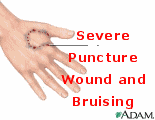
An animal bite can result in a break in the skin, a bruise, or a puncture wound.
If the bite is a puncture wound, it has a greater chance of becoming infected.
Rabies is a rare, but potentially fatal, disease transmitted by the saliva of a rabid animal. If you believe an animal may be rabid, notify the proper authorities. DON'T go near an animal that may be rabid. Examples include a raccoon who is active during the day, a stray pet, an animal that is acting strangely, or one who bites unprovoked. Be particularly cautious with bats. Some doctors believe that any potential contact with a bat, even simply seeing a bat in your house, requires a rabies vaccination.
There is no cure for rabies once symptoms develop. But, if vaccinated promptly after being bitten, you can develop immunity before symptoms develop.
If you believe you may have been exposed to rabies, you must get vaccinated immediately.
Studies have shown that in cases where a person contracted rabies from a bat, many of the victims were not even aware they had been bitten by a bat. If you see a bat in your house or a bat touches you in any way, you should contact a health care provider immediately for advice.
Many animal bites, even if rabies vaccination or stitches are not required, should be treated with antibiotics. Animal bites to the hand or fingers especially warrant antibiotics. If you have any doubt about the need for treatment, seek medical care.
Pets are the most common cause of bites, with dog bites occurring most often. Cat bites may have a higher chance of infection (due to their longer, sharper teeth, which can produce deeper puncture wounds). Stray animals and wild animals, such as skunks, raccoons, and bats, also bite thousands of people each year.
If you are bitten by a wild animal or an unknown pet, try to keep it in view while you notify animal control authorities for help in capturing it. They will determine if the animal needs to be impounded and checked for rabies. Any animal whose rabies vaccination status is unknown should be captured and quarantined.
Possible symptoms include:
- Skin break with or without bleeding
- Puncture-type wound
- Major cuts
- Crushing injuries
- Bruising
In addition, certain diseases can also be transmitted through bites. The symptoms of these may include flu-like symptoms, headache, and fever.
DO NOT go near an animal that may have rabies. DO NOT try to catch it yourself
If an animal's behavior is strange, it may be rabid. Notify the proper authorities. The police can always direct you to the proper animal control authorities. Tell them what the animal looks like and where it is so they can capture it.
Call 911 if the person has been seriously wounded -- for example, if the person is bleeding significantly and it will not stop with simple first aid measures.
Call your doctor or go to a hospital emergency room if:
- The person was bitten by an unknown or wild animal.
- The person has not had a tetanus shot within the past 5 years. (If a person has not had a tetanus shot in 5 years, a tetanus shot is recommended within 24 hours of any skin break.)
- There is swelling, redness, pus draining from the wound, or pain.
- The bite is on the face, neck, or hands.
- The bite is deep or large.
- You aren't sure if the wound needs stitches.
Report the bite to the local animal control authorities, even if you don't seek professional medical care. This will allow authorities to test the animal and prevent further incidents.
Auerbach PS. Wilderness Medicine. 4th ed. St. Louis, Mo: Mosby; 2001.
Mandell GL, Bennett JE, Dolin R, eds. Principles of Infectious Diseases. 5th ed. New York, NY: Churchill Livingstone, 2000:3202-3204.
Marx JA, Hockberger RS, Walls RM, eds. Rosen’s Emergency Medicine: Concepts and Clinical Practice. 5th ed. St. Louis, Mo: London: Mosby; 2002:774-780.